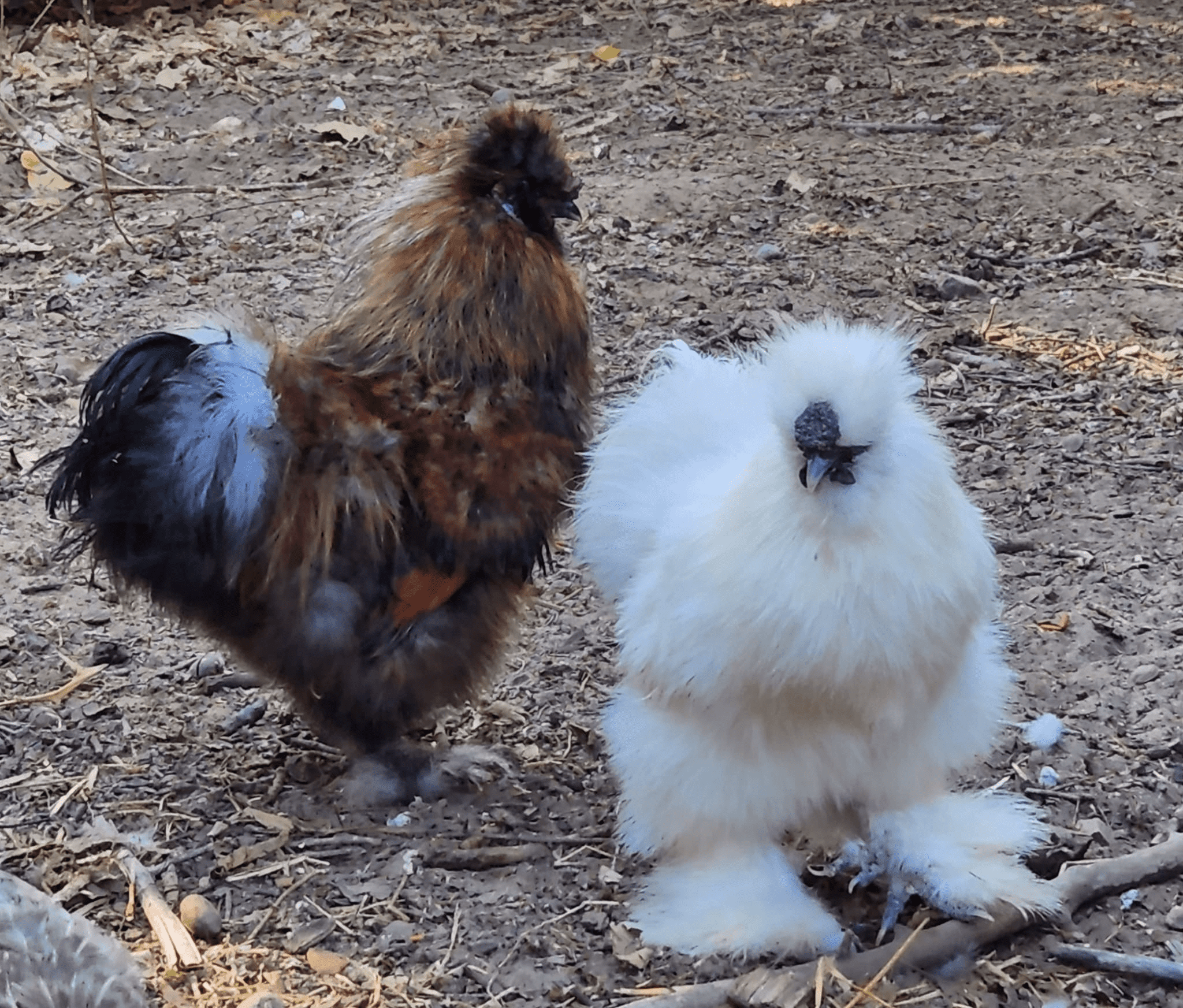Here’s what to know about adding a Silkie chicken to your flock. These friendly, small chickens are ideal for beginners and backyards. Silkies have luxurious plumage, which feels like silk or satin. Their notable characteristics include black meat, puffy feathers, and tufts on their heads. They look like fluffy chickens.
Silkie hens were bred to be broody. This breed makes excellent mothers and can rear the offspring of other birds as well. You can raise the females to incubate other eggs.
They are considered bantams. They lay small eggs. In addition to raising Silkie chickens for eggs, you can use them for meat when they reach market weight. However, if your purpose for raising chickens is for meat, you wouldn’t choose this breed. Many people choose to keep Silkie chickens as ornamental fowl and for exhibition.
Raise these mild-mannered chickens with other docile chicken breeds. Silkie roosters are not as aggressive as other breeds; however, they will still do a good job protecting their flock.
Silkie Chicken
People raise Silkies for eggs, as pets, or as ornamental fowl. Silkie chickens are considered productive in that they will produce a few eggs per week. In addition, farmers have noted an even better use for them.
Silkie hens go broody and make excellent mothers. They will sit well and hatch eggs from less broody chicken breeds. This makes them ideal if you want to hatch chicks.
They also lay fairly reliably throughout the year, even as natural daylight decreases in the colder, winter months.
Temperament and Behavior
The female Silkie’s friendly and gentle temperament makes it an excellent mother, and for it to do well in confinement or when interacting with children. As a downside, they are low in the pecking order. Their calm nature often results in Silkies being bullied by more active and aggressive breeds when there are mixed flocks.
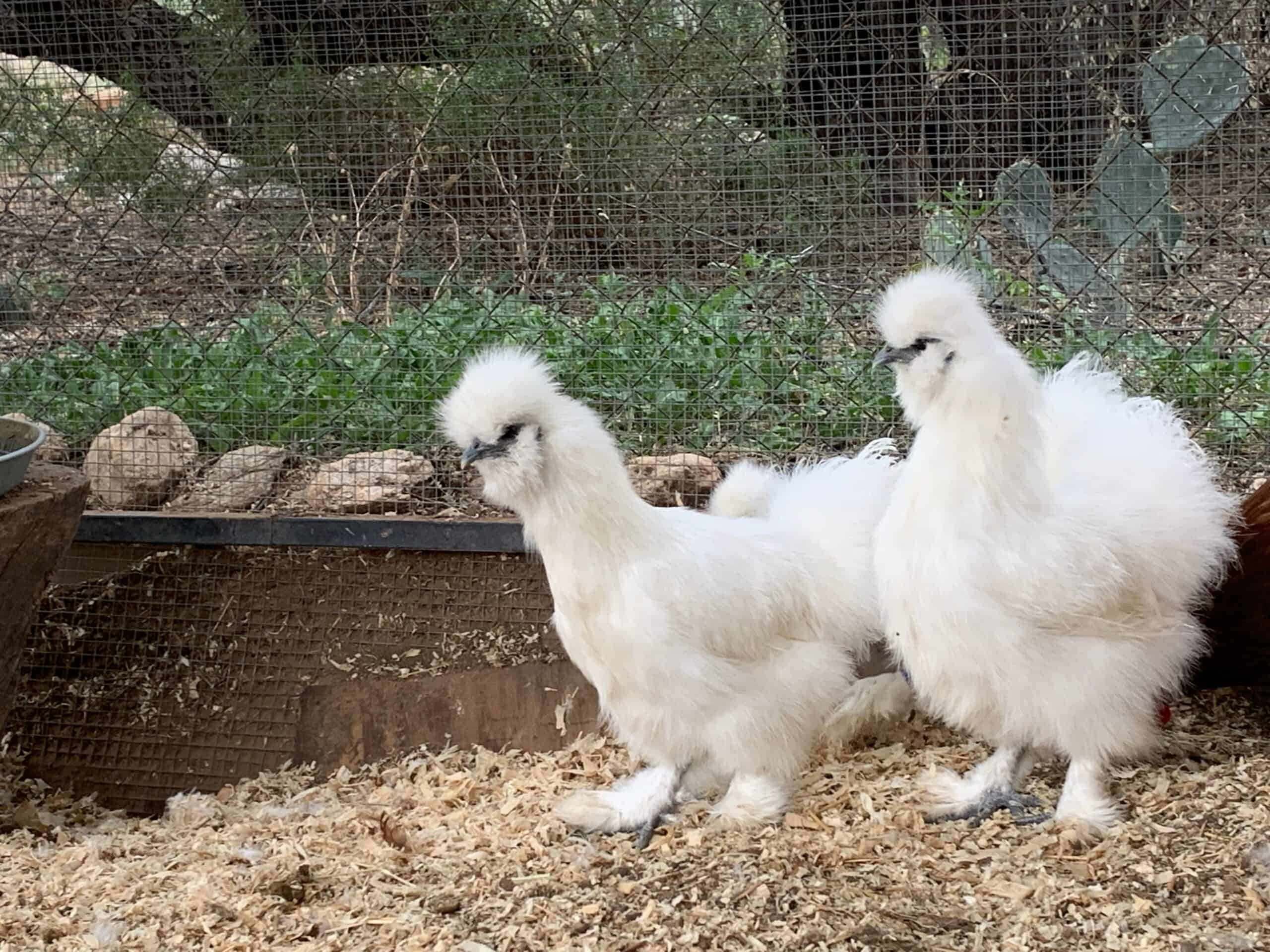
The males are incredibly docile and quiet compared to other male chickens. Silkie roosters will work to protect their flock but will not be dominant in a mixed breed. Keep a minimum of 8 hens per rooster.
These chickens do not tear up grass or gardens and are small and easy to manage. Both beginners and experienced farmers can raise this breed of chicken without hassles.
Silkie Hardiness
When choosing chickens for your small farm or homestead, it’s important to consider your climate. While all chickens need shelter, some will do better in colder climates than others.
A Silkie will do best in a moderate climate. They will not thrive in cold climates or damp, wet climates without a supplemental heat source. Be sure to keep their feathers dry when it’s cold. Silkies aren’t cold hardy birds.
Silkie Chicken Eggs
Technically, a dual-purpose breed, you wouldn’t want to rely on them for a steady source of eggs. On average, Silkies lay 100 eggs per year. This averages to 3 – 4 eggs per week. Their eggs are small and either white, cream-colored, or tan. If you want to hatch them, you will need a rooster so they are fertilized. Silkie hens are good setters and mothers.
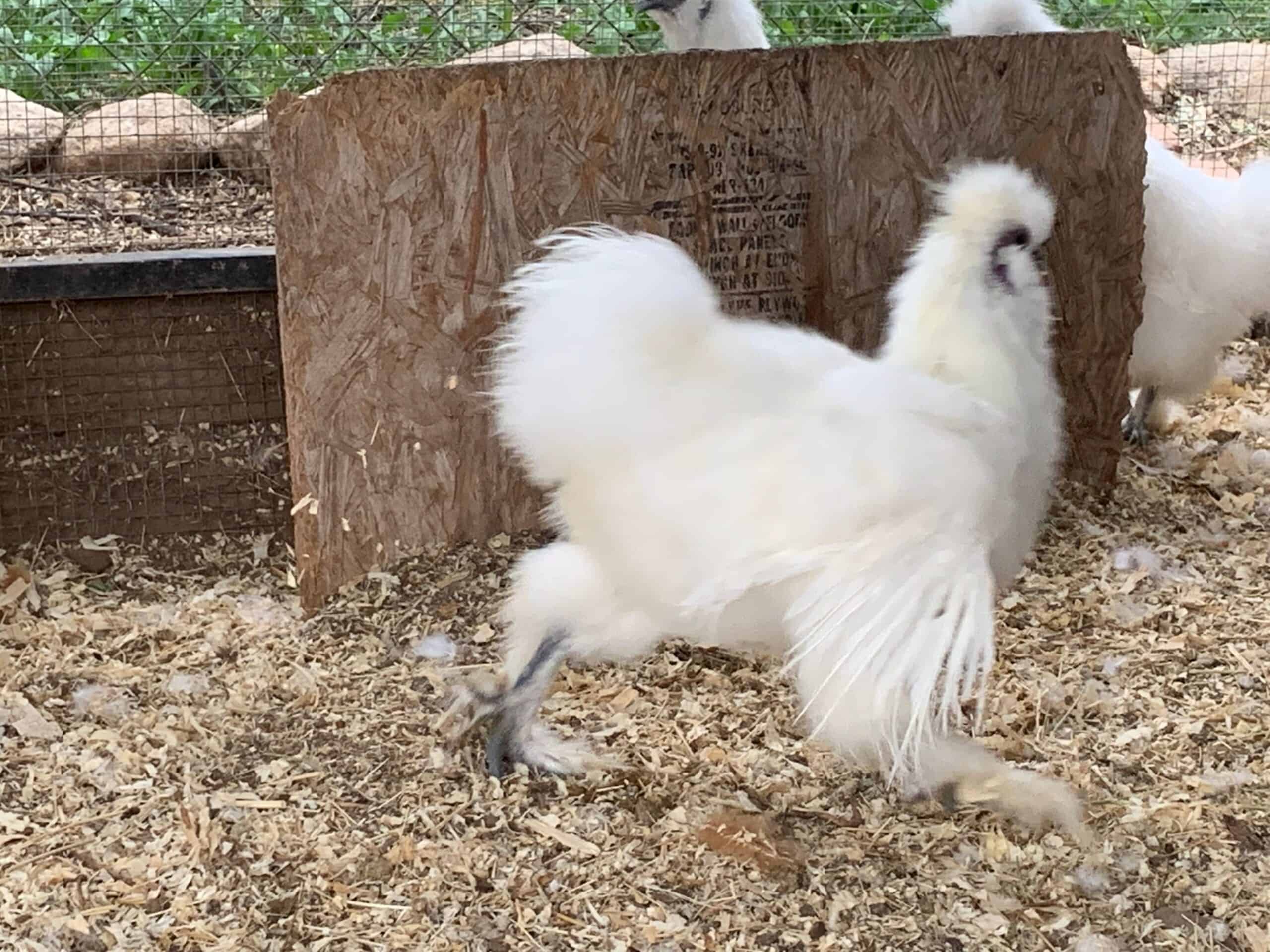
Silkie Rooster
Add a Silkie rooster to your flock if you have a minimum of 6 – 8 hens. These roosters will be a good option if you have nearby neighbors who may be disturbed by larger, louder roosters.
Silkie roosters, being bantam sized, aren’t as domineering and aggressive as roosters from many other breeds. However, they will protect their flock. Be sure to raise Silkies roosters with other docile breeds. If you are just getting started with raising chickens and roosters, Silkies is a good way to start. See a Silkie rooster in the video below.
Other Purpose for Raising Silkies
While they are smaller birds, you can eat their meat as well. It is black. They do make fantastic mothers as they are broody. You can use them to hatch baby chicks. They are friendly, docile chickens and fun to own as pets but there are other chicken breeds to consider if you want them as a food source.
Silkie chickens are also ideal for agriculture projects, including 4-H and FFA, because of their gentle nature.
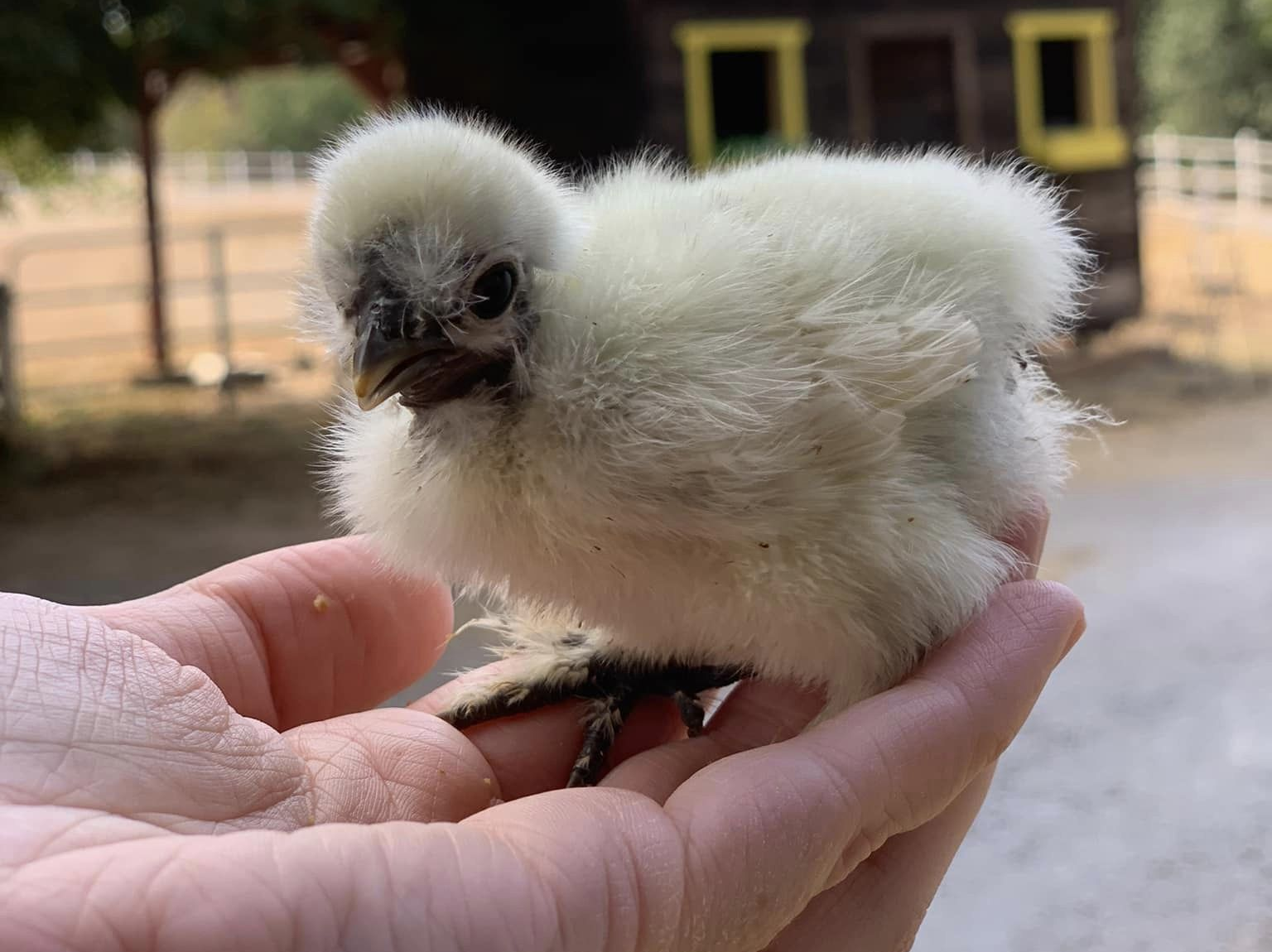
Silkie Chicken Lifespan
With proper care, Silkie chickens can live up to 8 – 9 years. Provide healthy food, fresh water, enough space, and opportunities for free ranging. Keep a clean home for them by cleaning the droppings regularly. Be sure to protect their coop and pen from predators.
In addition, raise them with other Silkies or other docile chicken breeds or other friendly bantams. This can keep them safer and minimize any stress. Also, if you decide to raise a Silkie rooster, be sure to have at least 8 hens. These factors will affect how long do chickens live.
Silkie Chicken Appearance
The appearance of a Silkie can vary. These chickens can be classified as bantams or by many breed standards, large fowl. They are fluffy-looking and look very different from other chicken breeds.
Silkies can be in a variety of colors. They may have white, black, gray, brown, or golden feathers. Black Silkie chickens have black feathers while a Blue Silkie chicken has blue-ish, lavender, and grayish feathers.
Others may appear blue as in the blue splash bearded Silkie chicken. They have a dark skin color. It can be black or bluish skin.
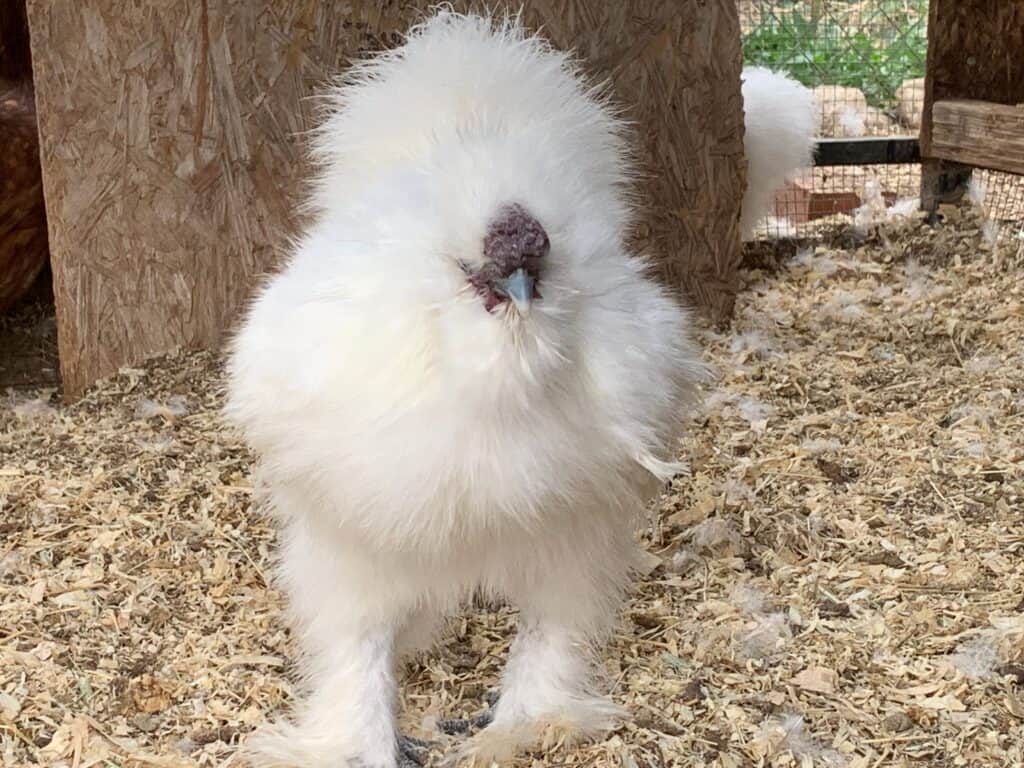
As a fluffy chicken, the Silkie plumage is its most notable characteristic. However, other crossbreeding has made Silkie feathering a possibility in other breeds like the Chabo, which is found in Europe but not in North America.
Some people compare the plumage of the Silkie to silk or satin, while others call it fur. Overall, these birds have a soft and fluffy appearance, which makes them fun to pet and maintain.
Their feathers lack functional barbicels, which means the Silkie cannot fly or leave the ground. Their poofy, pom crested head looks similar to the Polish chicken. People describe them as fluffy chickens.
- Silkie roosters weigh up to 4 pounds / 48 oz
- Females weigh approximately 2 – 2.5 pounds / 32 – 40 oz
The European and American Standards of Perfection call all Silkies bantams, regardless of their actual appearance. The standards of perfection also require a Silkie to have a small walnut-shaped comb, dark wattles, and turquoise or blue earlobes, which can be hidden by the tufts on the head.
All Silkies have five toes, which is an unusual trait for chickens. They share this characteristic with other exotic breeds like the Dorking, Faverolles, and Sultan.
Besides these basics, all Silkies have bluish or black skin underneath their plumage and will also have grayish-black meat and even black or bluish bones.
Silkie Varieties
These fluffy chickens can appear in one of two distinct varieties:
- Bearded
- Non-bearded
The Bearded Silkie has an extra muff on its head and feathers, which extend under the beak to cover the earlobes. In comparison, the non-bearded variety is missing the tuft and has a more noticeable beak and face.
When it comes to competitive showing and sale, Silkies are divided by color. There are many color varieties. At present, the recognized colors include black, blue, buff, grey, partridge, and white. Black Silkies can be bearded or non-bearded.
Alternative hues are available but lack official recognition. Some of these strange and unusual colors include the non-descriptive cuckoo, lavender, red, and splash.
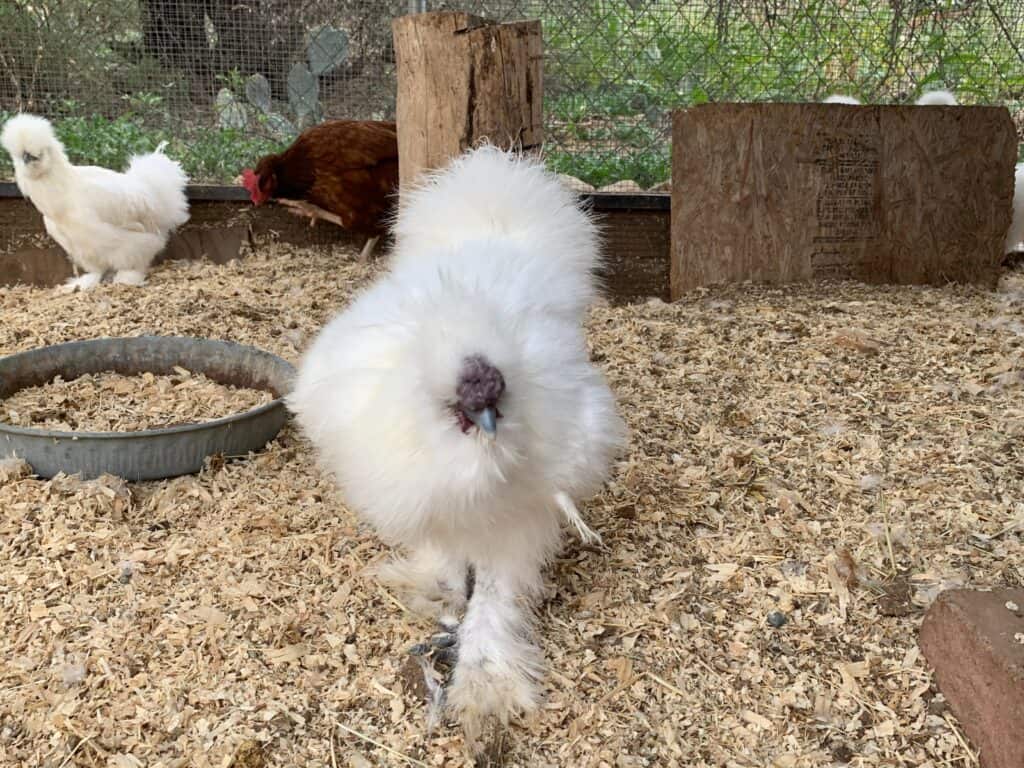
Silkie Chicken Varieties
Bearded Silkies:
- Black
- Blue Splash
- Buff
- Gold
- Lavender
- Lemon Meringue
- Porcelain
- Red
- Silver Partridge
- True Blue
- White Silkie
- White Gold Splash
Non-Bearded Silkies:
- Black
- Blue
- Buff
- Gray
- Partridge
What Are Silkie Chickens Good For?
Before choosing chicken breeds, it’s important to consider why you want to raise them. Silkies do not produce a lot of meat and are not considered good meat chickens like other chicken breeds. While you can slaughter the males or when the hens stop laying eggs, you shouldn’t choose to raise Silkie chickens if you want meat birds.
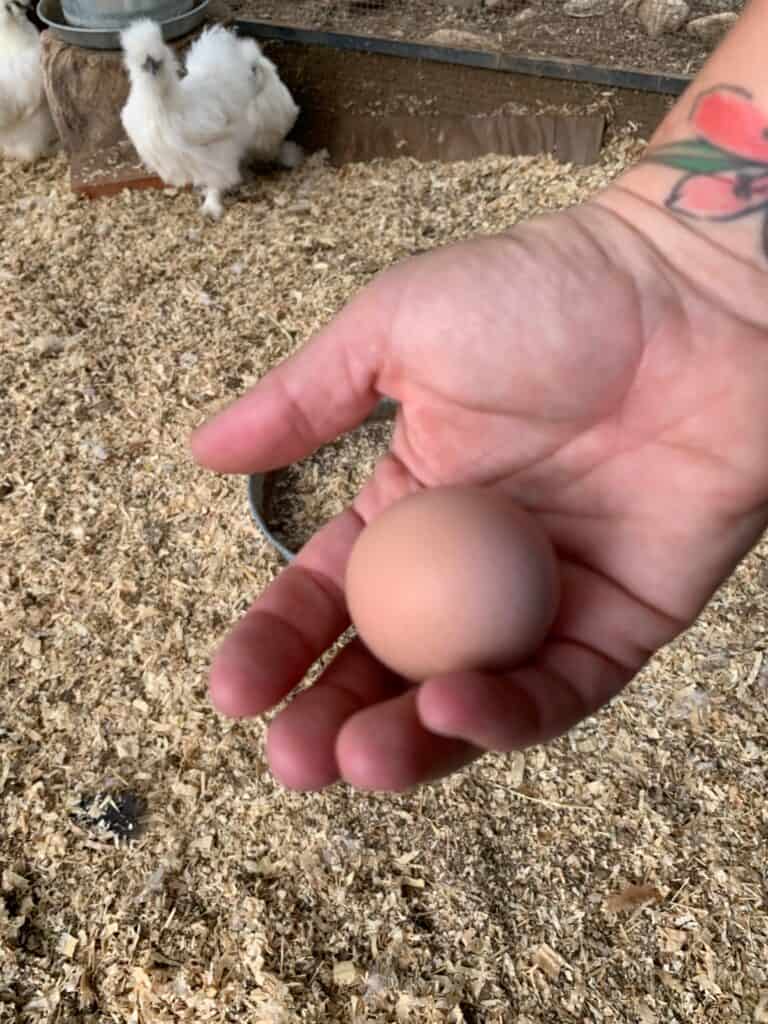
When it comes to Silkie eggs, hens lay cream-colored eggs throughout the year, even through the winter in some cases. Some of their eggs will look white and some will appear cream or light tan.
Egg production for the average Silkie is around 3 eggs a week, but it often goes broody and will stop producing. Their eggs have rich and large yolks and a relatively small white. The eggs are smaller than eggs from larger breeds.
In addition to producing eggs, Silkie hens are known for their broodiness. Because of their broody nature, they can raise the chicks of other fowl. They are excellent mothers and teach proper behavior with their maternal instincts.
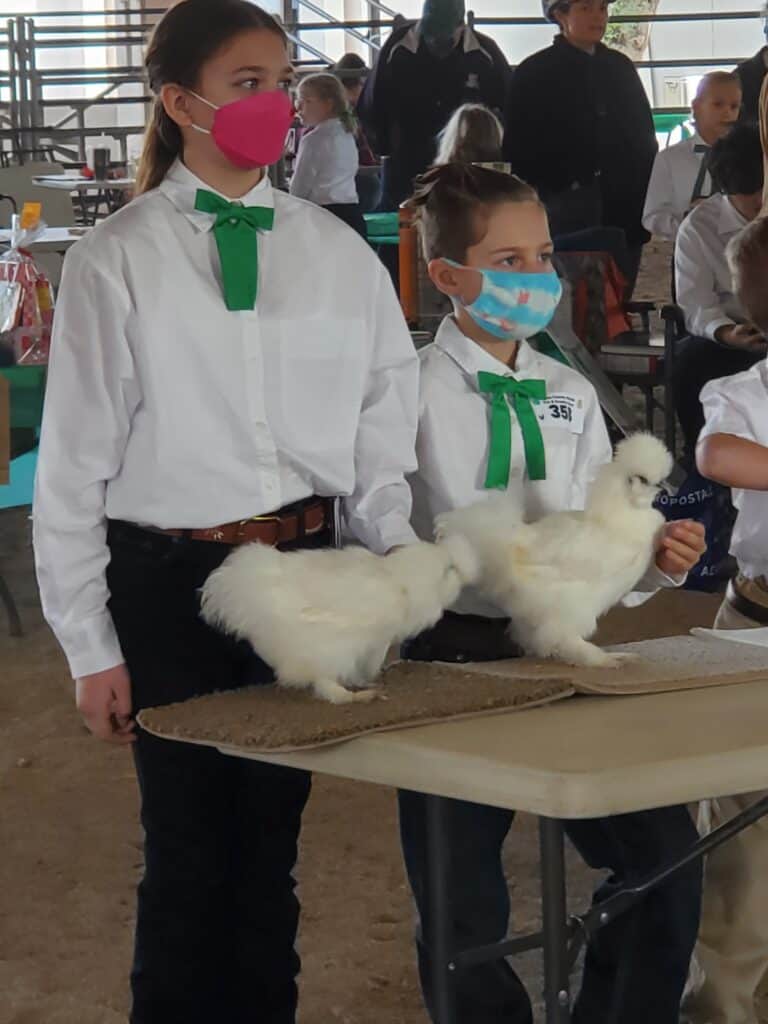
While Silkies are good for eggs, they are considered ornamental. Many people show Silkies. In addition, Silkie chickens make great pets. They are Bantam, a smaller breed, and docile. Their best use is to hatch eggs from other hens as they often are broody.
Are Silkie Chickens Good to Eat?
The Silkie can be eaten but is not often used for cuisine in Europe or North America because the color of the meat often puts off individuals used to pink or white flesh.
At the same time, as mentioned, Silkies produce little meat compared to other chickens, so it does not make sense to breed them for meat.
That said, most Asians, like Chinese, Japanese, Cambodians, Vietnamese, and Koreans, consume Silkie meat. Some of the usual cooking methods include using Silkie to make broth, braising, and in curries. In ancient Chinese medicine, chicken soup made from Silkie meat was considered a curative and great for restoring health.
Why Is Silkie Chicken Meat Black?
It should be mentioned that the Chinese language name for these chickens is wu gu ji, which means “black boned chicken”. The meat of a Silkie chicken is black because of a condition called fibromelanosis, which is a mutation in domestic chickens believed to originate in Asia. It allows melanism to extend beyond the skin and into an animal’s connective tissue.
There are several other breeds of chicken that also have black meat. Despite the unusual color, it is perfectly fine to eat a Silkie chicken, and you will not experience any side effects.
What Does a Silkie Chicken Taste Like?
The meat of a Silkie has the same excellent chicken taste but tends to be stronger and leaner. That is why it is often incorporated in soups and sauces and not eaten outright as a breast or fried in large pieces.
Plus, Silkie meat is rich in amino acids, protein, and Vitamin B. It is also far less greasy than traditional chicken and works well with stronger seasonings.
Silkie Chicken History
The first mention of a Silkie appears in a 13th-century account written by Marco Polo about his travels in Asia. He describes it as a “furry chicken” and noted they were prized for their feathers.
Agricultural historians think the Silkie chicken breed originated in ancient China, Japan, or India. It made its way to Europe through the Silk Road and eventually came to North America in the 19th century, where the Standard of Perfection accepted it.
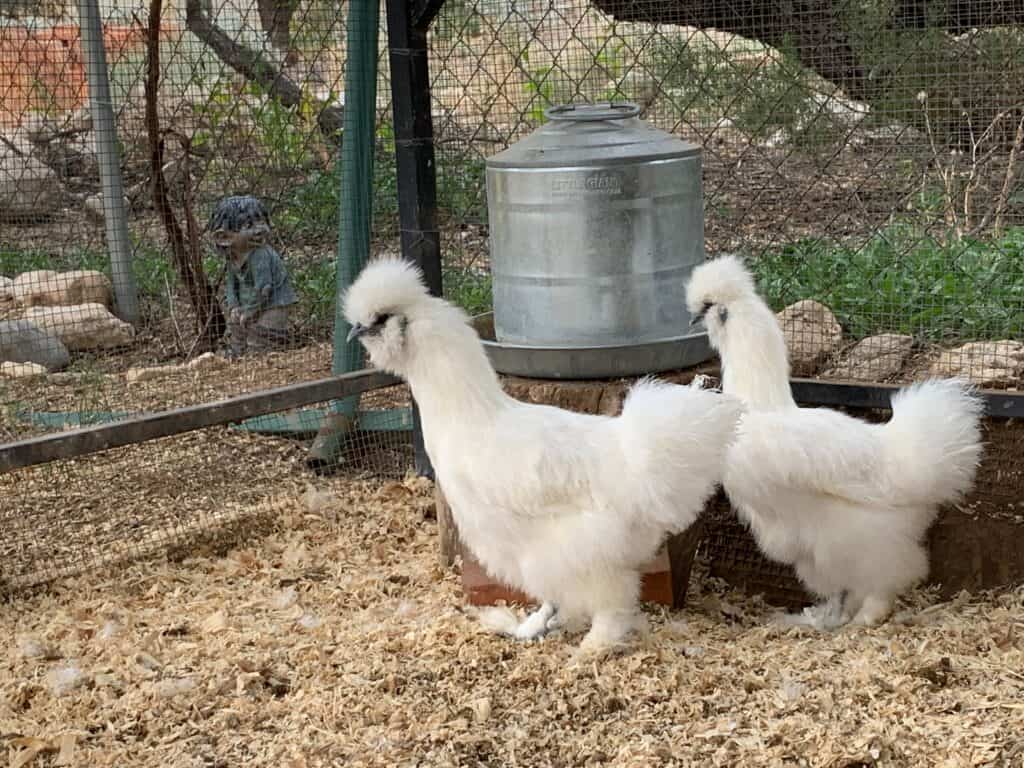
FAQs
Do Silkie chickens lay eggs to eat?
Yes, Silkie hens lay eggs you can eat. Silkies lay 3 – 5 eggs each week.
How long do Silkie chickens live?
With proper care and shelter, silkie chickens can live 7 – 9 years. Their lifespan will depend on their conditions and overall health. They aren’t cold tolerant; choose them if you live in a temperate area.
How cold is too cold for Silkie chickens?
Not being cold hardy, they will need to stay dry and warm in cold months. They should not get wet during this time. Above freezing (32 degrees F) is ideal.
Do Silkie chickens like to be held?
Most Silkie chickens like to be held. It helps to handle them safely when they are young so they get used to it. They do have a lot of energy. Some will sit for long periods and can be considered lap chickens; however, personalities vary.
Are Silkie chickens good for beginners?
Yes, Silkie chickens are good for beginners because they are small, friendly, and have easy-going dispositions. They are easy to handle and the roosters are smaller and less aggressive.
Are Silkies good pets?
While everyone has their definition of what makes a good pet, if you want a friendly, fluffy, cute animal, look no further than a Silkie chicken! If you raise a female, you will have a productive, egg-laying pet as well. They don’t fly which also makes them easier to handle.
Do Silkies like to cuddle?
While they are affectionate, each Silkie has its temperament and personality. If you snuggle and cuddle them when they are younger, chances are, when they are grown, they will continue to cuddle.
Are Silkies hard to keep alive?
Like all chickens, you will need to protect them from predators. They are small and easy targets. In cold weather, be sure they stay dry and in a draft-free shelter. Silkies aren’t as cold tolerant as other chicken breeds.
Do Silkies need special care?
Take care to keep Silkies with other mild-mannered chickens and chicken breeds. Or keep them in a flock of only Silkie chickens. Due to their small size, any dominant chickens housed with them can be aggressive toward them and bully and hurt them.
In addition, they need to stay dry in cold temperatures. This is a concern for all chickens in cold months, but it is even more essential for Silkies because of their feathered feet and thick fur-like feathering.
What color eggs do Silkies lay?
Their eggs vary in color from white, ivory, cream, and light tan.
Silkie Chicken Care
In the USA, the Silkie chicken is one of the most popular breeds. It’s important to remember that many people in the Western world raise and care for Silkies as pets rather than as a source of food.
They do not produce many eggs compared to other breeds and enjoy affectionate owners. This breed is docile and great for gardens as a form of natural pest control.
Raising and caring for one is not difficult, but it’s important to keep your Silkie comfortable and healthy so that it lives a long, fulfilling life.
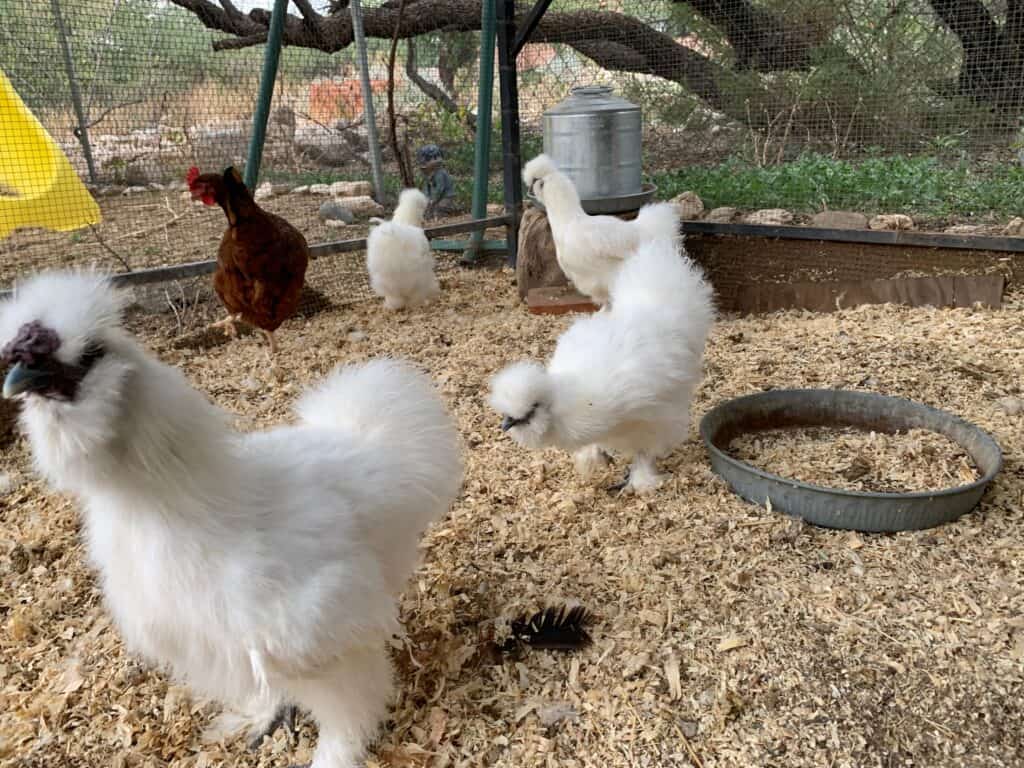
1. Housing
Appropriate housing is essential for raising all chicken breeds, including the Silkie. It is important to have a house or coop prepared before you bring a chicken home so that it has a private place to rest and recuperate.
The Silkie chicken is smaller in size compared to other common chicken breeds, so they do not require as much space. How Much Space Do Chickens Need
That said, they will be happier if you give them plenty of room in a simple chicken coop with secure walls and adequate bedding.
You can usually build or buy a chicken coop that will be spacious enough for the Silkie. Remember, chickens need room to roam, lay eggs, and stretch their legs when it rains or is cold outside.
While you can raise Silkies indoors, they appreciate being let out during the day. Fresh air, sunlight, and the ability to free range will help keep them healthy.
They do not eat common garden plants and are excellent for pest control since they eat caterpillars and small insects.
If you want your Silkie to live both indoors and outdoors, the coop can be smaller than one meant for a completely indoor lifestyle. Best chicken wire for chicken coops
Bedding
Silkies need comfortable bedding. There is a broad range of bedding materials available, so choose one which will be pleasant to roost upon.
- Wood Shavings: These are considered one of the best bedding materials because they are soft, absorbent, and easy to clean.
- Sawdust, Straw, Newspaper Shredding: These are also good choices.
- Pine Needles: These are also a good medium choice but have the risk of once again irritating your Silkie by poking their sensitive skin.
Avoid sand because it is uncomfortable and can irritate your chicken’s skin. Hay is okay but is not absorbent. Make sure there is adequate bedding for all of your chickens and that there is space for eggs. Likewise, you will need to clean the bedding regularly.
2. Feeding and Watering
Finally, you need to maintain proper and adequate feeding and watering facilities to care for a Silkie chicken.
Feeds
While there are many chicken feed options, the total amount you need will depend on the type you are using as well as the overall size of your flock. You can find specialized feeds depending on your purpose of keeping a Silkie.
For example, there are layer pellets for chickens kept for eggs, and finisher feeds for those who will be used for meat. Breeding chickens should be given a well-balanced diet.
If you are keeping Silkies as a simple pet, though, you should be fine with layer pellets or standard chicken feed.
Silkies benefit from added grit for better digestion since they do not consume as much random material as other free-range chickens.
After hatching, you can feed baby chicks a regular chick starter for overall health and wellness. Choose a good chicken feeder to prevent waste.
Silkie Chicken Treats
Besides these feeding basics, you can give your Silkies a limited amount of treats. They love table scraps, insects, seeds, fruits, and vegetables.
If your Silkies are pets, you can give them just about anything, and they will be happy. They enjoy a broad range of fruits and vegetables like cucumber, watermelon, strawberries, and broccoli, and can also eat fish, cooked eggs, meal works, pasta, rice, and even bread. Cooked potato is another good choice.
Water
Finally, make sure your Silkie has an adequate amount of fresh and clean water. How long can chickens go without water Be sure to refill containers daily, and be sure to clean them once a week?
Since Silkie chicks are small and can drown, having an automatic waterer is ideal. Water your backyard chickens ideas
3. Other Tips and Tricks
Besides the basics of housing and feeding, there are a couple of other ways you can better take care of your Silkie. In particular, you want to pay attention to their health, social behavior, and comfort when they’re in their coop.
Health
It’s important to ensure you are keeping your chickens healthy and strong. That means calling a veterinarian if your Silkie begins to exhibit signs of illness such as depression, sneezing, a loss of appetite, or discolored stool.
Chickens can pass diseases and bacteria to one another, so ensure the conditions are sanitary and any unhealthy Silkies are isolated in a comfortable area until they become well.
Dominance and Aggression
As mentioned earlier, the Silkie’s calm temperament makes it a prime target for bullying from more active and aggressive breeds. If you notice aggressive behavior among your flock, separate the chickens getting into fights.
They might be experiencing dominance issues and can severely injure or even kill one another. Having separate chicken coops is an option to keep both chickens happy and healthy. Raise this docile breed alongside other less aggressive and dominant chicken breeds.
Heating for Silkie Chickens
While they are hardy for the winter, you will need to give them appropriate shelter from the cold. If you live in a cold climate, consider purchasing a heat lamp for the winter months.
For safety, keep the heat lamp away from cobwebs and debris. Remove potential obstructions as often as possible to reduce the risk of fire.
At the same time, keep the coop well-ventilated. Silkies can overheat easily and should have adequate access to fresh air and water to avoid overheating and dehydration. In addition, to ensure their water doesn’t freeze, you may consider a chicken water heater.
Conclusion
The Silkie chicken name is appropriate. This fluffy chicken is prized around the world for its unique puffy plumage, unusual black skin and bones, and docile temperament.
They are excellent pets and starter chickens for individuals to enjoy their calm personalities. The hens have great mothering skills. Because they are excellent brooders and go broody multiple times each season, they can be a resource to hatch eggs from other chicken breeds, ducks, etc.
While it isn’t eaten often in North America or Europe, it is possible to find traditional dishes throughout Asia which utilize Silkie meat and bones for the chicken’s unique taste and nutrition.
If you plan to raise them, make sure you do not house Silkies with more aggressive chicken breeds. Pay special attention to bedding and avoid overheating or dehydration.
You can raise Silkies in small groups. They integrate nicely into backyard gardens and hobby farms and make ideal pet chickens with reliable egg production. Showing Silkies is popular as well.
Learn more about bantam chickens to see if they are right for your backyard. See my lovely Golden Sebright bantams and these Belgian Bearded d’Anver bantams.

